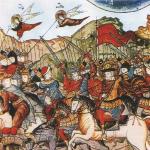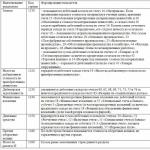Since time immemorial, tailors have been using chalk to make marks when cutting or trying on a product. I advise you to take the regular one school chalk without any admixture of wax, because on modern fabrics that have undergone special treatment, wax will leave indelible stains. However, even ordinary chalk hardens during use and becomes unusable. To prevent this from happening, insert a piece of chalk into a special holder. The lid of the holder has a protrusion for sharpening chalk.
Special tailor's chalk Available in the form of small rectangles in white, blue or red.
Copy roller
 This wonderful instrument has been known for a long time, but until recently it was undeservedly forgotten. Copy roller allows you to easily and accurately trace the contours of patterns on fabric.
This wonderful instrument has been known for a long time, but until recently it was undeservedly forgotten. Copy roller allows you to easily and accurately trace the contours of patterns on fabric.
Its previous version had sharp edges that damaged the fabric. New tool designed in such a way that it does not damage even the most delicate tissues and at the same time allows for very precise marking through large sheets of special copy paper.
Of course, carbon paper, especially dark-colored paper, requires careful handling, otherwise permanent stains will remain on the fabric. That's why it's better to use paper white, and take dark only in cases where other colors are not noticeable. Transfer paper is always placed on the wrong side of the fabric.
The toothed wheel is the most commonly used copy wheel. Used in conjunction with carbon paper. When drawn over carbon paper, dotted lines remain on the cut details. Using a wheel and carbon paper, it is convenient to transfer darts and sewing lines decorative elements, mark the location of the loops.
Wheel without teeth

The smooth wheel is used, like the first option, to transfer lines. But in in this case the line turns out to be one continuous line. They are comfortable working on thick coat fabrics.
Double wheel

It is used to outline the entire part, while immediately marking the seam allowance. The design of the wheels allows you to change the width between them. It is especially convenient to use such a tool when the pattern is already given with allowances and when transferred to the fabric, only the outer contour of the cutting is outlined and the seam lines are not visible. In this case, the seam lines can be drawn using the double wheel.
How to use the wheels

Place the pattern pieces on the fabric and pin them together. Place a piece of carbon paper between the fabric and the pattern so that the ink layer is on the fabric (in this case, facing down).
Use the wheel to follow the lines you want to transfer onto the fabric. If the lines are hard to see, you can move the wheel again, increasing the pressure.

If you are cutting two symmetrical parts at once on fabric folded in half, then using the wheel you can transfer allowance lines and other marks. To do this, copy paper must be placed under the folded fabric with the ink layer facing up.
Translating a pattern onto fabric, especially when sewing clothes, often involves transferring chalk lines from one symmetrical piece to another. But the same thing may be needed when sewing toys.
There are several ways to copy chalk lines. For example, using copy stitches. Or by pins. But I prefer one, the simplest and most accurate, in my opinion - transferring the markings from one part to another with a copy roller on a chalk board or using special copy paper.
The essence of this method is as follows:
1. When cutting paired symmetrical parts, the fabric is folded into 2 layers with the right side inward.
A pattern is placed and pricked on top and all the contours are traced. I talked about what you can use to trace the contours of patterns on fabric in the review “How to transfer patterns onto fabric?”
As a rule, all chalking is done along the wrong side of the right part.
2. Then the parts are cut out taking into account the necessary seam allowances.
Because The chalking is applied to the wrong side of the right part, then the left part is placed wrong side down on the side of the board or copy paper covered with a layer of chalk.
4. Then use a tracing roller to follow the chalk lines marked on the right part.
When copying marking lines onto a symmetrical part, the copier wheel should be located exactly in the middle of the chalk line. Otherwise, distortion of the symmetrical part may occur.
As a result, prints are obtained on the left part in the form of a line consisting of points close to each other.
5. After this, remove the pins and, if necessary, clarify the transferred lines using a ruler and pattern.
It is important to note that the quality of the copy line depends on the copy roller and the pressure applied. Which means it’s time to talk about what types of copiers there are.
Types of copy rollers
You can come across several names for a copy roller - copier, copy wheel, and even cutter. But the name “cutter” is consonant with the word “to cut.” And we’re not going to cut them yet. Therefore, we will not use this name, so as not to mislead anyone.
Copy wheels come with serrated and smooth edges. 
If the copier has very dull teeth or you press the cutter very hard, the line will be thick and blurry. And very sharp or damaged (bent, burred) teeth can damage thin fabric.
Also, the choice of copier depends on the pattern on the fabric. So, on fabric with small polka dots or with a very variegated small pattern, the line left by a serrated copier may simply not be visible.
But the copier itself cannot transfer marking lines to a symmetrical part. It “works” only in tandem with copy paper or a chalk board. 
To be honest, I have never used carbon paper. Although no, there were several times when I studied machine embroidery. Therefore, I cannot say for sure whether there is a fundamental difference in stationery carbon paper and carbon paper for fabric. I daresay the only difference is size.
If you use carbon paper when translating marking lines, please share which one you use. I'm very interested myself.
But if, nevertheless, a stationery carbon copy is not suitable, and it is expensive to buy specialized carbon paper, I want to make you happy! You can make a very convenient analogue with your own hands - chalk board.
And I have prepared to help you detailed instructions for making chalk boards. Share this article with your friends by simply clicking on any social button and download the instructions.
To prevent the underside of the left part from being stained with chalk or carbon copy paper, you must avoid pressing on the parts with your hands (palms, elbows), and do not lean on the part located on the chalk board. Otherwise, any pressure will be imprinted on the lower part.
You can also use this method to transfer a large appliqué design onto fabric. But it’s difficult to transfer an appliqué design made of small parts with a copy wheel – it’s a jeweler’s work.
To transfer an appliqué (or embroidery) design, place the base fabric right side down on a chalk board. On top, on the wrong side of the base, place tracing paper with a pattern. Just remember to turn the tracing paper over so the design is facing down, otherwise the image will end up as a mirror image. Secure the tracing paper with pins and trace the contours with a wheel.
This is how I transferred the appliqué design to my graduation dresses. Very comfortably!
And in conclusion, I suggest you watch an excellent video about using a copier to translate patterns.
As I already wrote, this method is very easy to use and quite accurate. If you want to use it, you will need to purchase a tracing wheel and fabric transfer paper or make a chalk board.
Teacher at GRASSER school
A professional designer has many different interesting “things” that are indispensable work assistants. Let's talk today about CUTTER - many call it copy roller, or copier, wheel. It's all the same thing. It looks like a jagged wheel on a handle.
How does a pattern maker use it in his work? When the model drawing is ready, it must be transferred to thick pattern paper. This is where the cutter comes in. A drawing is superimposed on the pattern paper, and the main and balance lines are drawn according to the drawing. On the pattern paper, the cutter leaves punctures of the required lines, and they are outlined with a pencil. Thus, it is possible to translate part of the structure during technical modeling or when obtaining new form based on the finished design.

Of course, this item can help not only professionals, but also sewing enthusiasts when working with patterns. Let's look at the area of application of the cutter.
Using a cutter, you can transfer to any thick paper so that you can work with it in the future. So that dotted lines were more noticeable, and the surface of the table was not damaged, use a cutting mat.
A copy roller will allow you to transfer the contours of the pattern onto the fabric. To do this, you will also need special copy paper, which can be bought at sewing stores. In this case, carbon paper is placed between the pattern and the fabric. The lines are drawn with a roller, leaving a trace of carbon paper on the fabric. But here you need to pay attention that this method is suitable for medium or thick fabrics. For very light fabrics or with a loose structure, the line will not be clear. As a recommendation, try it on a separate piece before starting work.
Using a cutter, you can transfer darts, pocket locations, and various control marks to the wrong side. To do this, copy paper is placed on the wrong side of the fabric, and a pattern is placed on top. The cutter is drawn along the lines that need to be translated. This method will replace labor-intensive transfer using pins.

If you decide that you need a cutter for your work, then when choosing, pay attention to the following: the wheel should turn easily, the notches should be sharp enough, and the body should have a special extended platform for the finger. With its help it is most convenient to hold the cutter.
Sew with pleasure!




